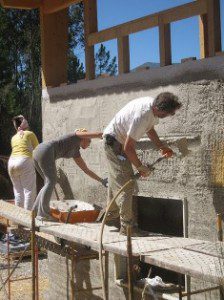 Straw Bale Building and Plaster Application – Which is best? Gunnite, Sprayed, or Hand-Troweled?
Straw Bale Building and Plaster Application – Which is best? Gunnite, Sprayed, or Hand-Troweled?
When applying plaster to the bales, the fastest application may not be the best. There are two schools of thought in plastering. Some believe that the plaster adheres better to the bales when sprayed with a plaster gun and others believe a hand troweled application provides the best adherence. I personally believe that either application method will work well.
The sprayed method applies more mud at a faster rate, but it is important that a second hand follows the gun to run a trowel over the plaster once it hits the wall. In the same way that you need to back roll paint that is sprayed on with a gun, back troweling plaster insures that an even coat is applied to all portions of the bales. I would only recommend applying plaster with a gun for the scratch and brown coats. The final coat is best applied by hand troweling.
Hand troweling is slower, but a cleaner application is accomplished. In addition, the pressure applied through the trowel creates a strong bond between the plaster and the straw and helps to work the mud into all the little nooks and crannies of the wall. Because you have more control with a trowel, less preparation and taping is necessary, although it is still important to protect areas where you don’t want plaster to splash or stick. If you have a bunch of helping hands, plastering parties can make quick work of even the largest bale walls and no special tools are required to get the job done.
Gunnite, the method and material used to create in-ground swimming pools, is often seen as a good option for the fast application of mud to bale walls. There are some benefits: the fast application and the structural strength of the material; however, the overall scope of the material makes it a bad choice for bale walls. The biggest concern with gunnite is the thickness of the mud it applies. In general, it is easy to shoot on 3″ or more in one application. This is too much for a bale wall and cracking may easily occur in the thick, un-reinforced material.
Those cracks are likely to run all the way through the mud to the bales as the material was applied in one layer, not a series of built up applications. Another concern is the make up of the material itself which is basically a small aggregate concrete with enough liquid to allow it to be sprayed through a mortar gun. The concrete creates a strong yet very unforgiving layer of mud. Moisture does not move through concrete well in vapor form when used as a plaster, so this application could cause damage to the bales from moisture build up in the wall.
Unless you plan on plastering a large number of structures, you are probably best to proceed with a hand troweled plaster. The skills needed are important, but a reasonable job can be done by even those just learning the process. As I said before, no special tools are required and no large machines need to be rented other than a mortar mixer. Be sure to start in an inconspicuous area so all of your learning will be well hidden when the job is done!

 Straw Bale Building and Plaster Application – Which is best? Gunnite, Sprayed, or Hand-Troweled?
Straw Bale Building and Plaster Application – Which is best? Gunnite, Sprayed, or Hand-Troweled?

2 Responses
Believe it or not ordinary table salt and pepper work great, salt tends to dry the insects body quickly which they don’t like and the pepper has a burn when they clean their legs again they don’t like the spice, just shake on shelves in drawers and under cabinets…hope this helps good luck
Dear Ross, im very interested in this technique and material. I was a plaster journeyman worked for Art in Construction the top color plaster company. We did waterproof color portland plaster for the likes of Rick Gere & Bob Deniro. Theres a big difference between amateur hunt&peck troweling and Craftsman strokes of trowel trade school like those in Ireland. Haha it hurts to watch untrained forehand hacks even if eventually it gets done.
Fascinating this is to me and its neighbor help neighbor put up the barn type work.
Truly we have to do all our own building food growing on & on.
Like to learn this & build out buildings and a painting studio for myself aint had one since i won a Pollock-Krasner art grant after the fire that took my studio & many important paintings. We have acres in hopewell junction ny. Our house is built 1776 eyebrow colonial. Yea i renovated all the wood lathe plaster.
They knew what they were doing cause i found laying scratch-coat just flys with a spritz of water on the lathe. Straw must be similar. Thanks from Nick